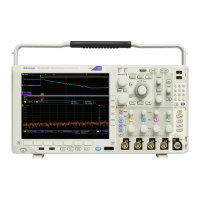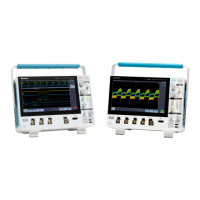Commands Listed in Alphabetical Order
WFMOutpre?
ACQuire:MODe
Arguments
<Block> is the waveform data in binary format. The waveform is formatted as
follows:
<IEEE488.2 binary block header><data><newline>
<IEEE488.2 binary block> is the header, which is defined as #N<N-digits>
N is a single decimal or hexadecimal digit indicating the number of digits
to follow.
<N-digits> are the decimal digits representing the number of bytes in
the data that immediately follows this binary block header. (Use the
WFMInpre:BYT_Nr command to set the width for waveforms transferred
into the oscilloscope. Use WFMOutpre:BYT_Nr to set the width for
waveforms transferred out from the oscilloscope.)
<data> is the curve data.
<newline> is a single byte new line character at the end of the data.
<asc cu rve> is the waveform data in ASCII format. The format for ASCII data
is
<NR1>[,<NR1>..], where each <NR1> represents a data point. For RF frequency
domain waveforms, the data is transmitted as 4-byte floating point values (NR2
or NR3).
Examples
CURVe 0 ,1,4,32,-120 … — This command sends ASCII data values to the
specified destination reference waveform (DATa:DESTination).
CURVe # 510000<10000 binary bytes> — This command sends
10,000 binary data bytes to the specified destination reference waveform
(DATa:DESTination).
CURVE? with ASCII encoding, START and STOP of 1 and 10 respectively, and a
width set to 1 might return
:CURVe 61 ,62,61,60,60,-59,-59,-58,-58 ,-59
CURVe?
with ASCII encoding, START and STOP of 1 and 5
respectively, and
DATa:SOUrce set to RF_NORMal might return :CURVE
1.20635E-11,6.30522E-12,1.46334E-11,8. 97143E-12,4.87173E-12.
CURVe?
with ASCII encoding, START and STOP of 1 and 5
respectively, and
DATa:SOUrce settoRF_NORMalmightreturn:CURVE
1.20635E-11,6.30522E-12,1.46334E-11,8. 97143E-12,4.87173E-12
.
2-272 MDO4000/B/C, MSO/DPO4000B and MDO3000 Series Oscilloscopes Programmer Manual

